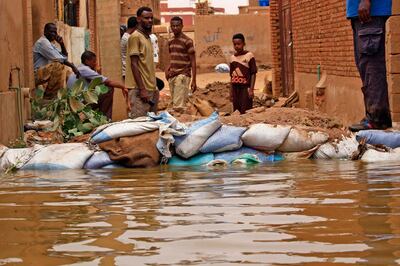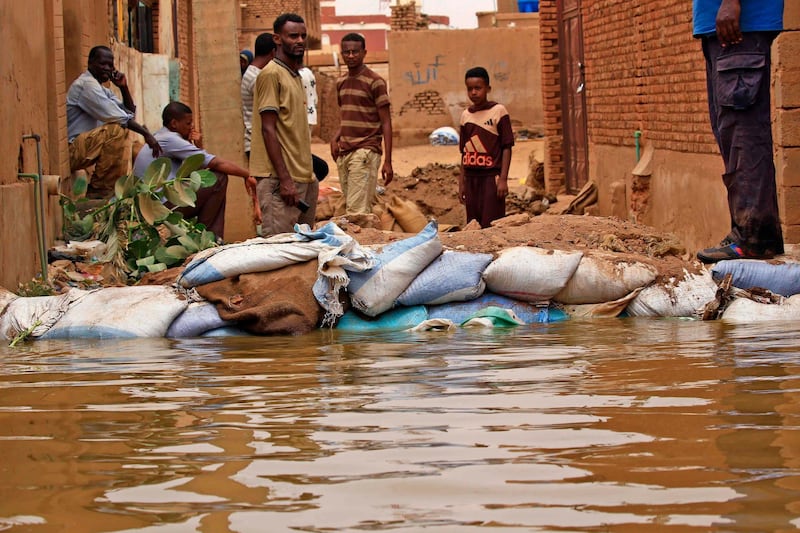Sudanese living near the Blue Nile in the capital Khartoum shored up flood defences on Thursday, as weather forecasters predicted more heavy rain over the weekend for many parts of the country.
The government, meanwhile, held an emergency meeting late on Wednesday night to review measures taken to avoid a repeat of last year’s flooding, which claimed about 100 lives and inundated more than 10,000 homes across the vast Afro-Arab nation.
Also late on Wednesday the authorities reported that four people had died as heavy rains battered parts of the country. A mother and child were crushed when the ceiling of their home south of the capital caved in under the weight of the rain, and two men were electrocuted in northern Darfur.
Those living in Khartoum described the efforts under way to protect people and properties in the capital.
“We have built two lines of defences, one right on the river’s banks and another about a metre away,” said Khider Massoud, a resident of Khartoum’s Tuti island on the Blue Nile.
“The river’s water level is rising and it looks frightening. Youth committees on the island are helping authorities strengthen defences on the river’s banks.”
Tuti is a short distance from the confluence of the Blue Nile, which has its source in Ethiopia, and the White Nile, which originates in central Africa.
Together the two form the Nile, which travels north through the deserts of Sudan and the entire length of Egypt before reaching the Mediterranean Sea.
In the Khartoum suburb of Karaklah, housewife Saadiyah Hussein said she and other residents there were apprehensive because their district was hit hard by the flooding last year.
“We have surrounded our homes with sandbags and debris. We were scared last year and we are scared this year, too. Last year’s damage is still with us now,” she said.
The Blue Nile, the river’s main tributary, swells significantly in July and August every year as a result of rainfall on the Ethiopian Highlands. Ethiopia is building a huge hydroelectric dam on the river barely 20 kilometres from Sudan’s border.
The Grand Ethiopian Renaissance Dam is heralded by Addis Ababa as the country’s ticket out of poverty.
The mega project has galvanised the ethnically and religiously diverse nation of more than 100 million, who view the dam as a symbol of Ethiopia's sovereignty.

Downstream Egypt and Sudan, however, have been pressuring Ethiopia to enter a legally binding agreement on the filling and operation of the dam to minimise its impact on their share of the river’s water and to avoid flooding.
Ethiopia says guidelines should suffice and has sought frequently to assure its two fellow Nile Basin countries that no harm will come to them from the dam.
A decade of negotiations over the dam has yielded no deal, with the last round of talks breaking down acrimoniously in April. No announcement on a date for their resumption has been announced.
At a news conference in Khartoum on Wednesday Sudan’s irrigation minister sought to blame Ethiopia for any material damage or loss of life if the flooding in his country took a turn for the worse.
Ethiopia, he said, provided Sudan with little data on the water level of the Blue Nile or the rainfall on the highlands, endangering the safety of the half of Sudan’s population of 40 million who live in areas vulnerable to flooding.
“Information from Ethiopia is a must to safely operate the Roseires dam,” said the minister, Yasser Abbas, referring to Sudan’s hydroelectric dam on the Blue Nile. “The Renaissance Dam has many advantages for Sudan, but only if there is an exchange of information with the Roseires.”
Giving an example of the information provided by Ethiopia, the Sudanese minister said Addis Ababa had formally told Sudan on July 5 that it intended to carry out a second filling involving 13.5 billion cubic metres, when in fact it held only four billion cubic metres.
Although last year’s first filling involved about five billion cubic metres of water, it disrupted work at water treatment plants, leaving tens of thousands of Sudanese households without drinking water.
Egypt was not affected however, because its water reservoir behind the Aswan dam was filled to near capacity thanks to a bumper flood, which is expected to be repeated this year.







